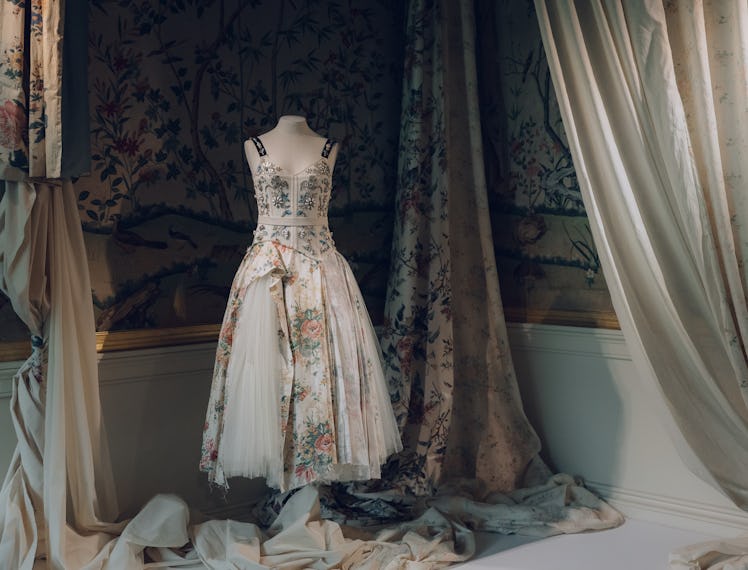For Erdem Moralioğlu, there’s no better muse than a multifaceted heroine. The Italian aristocrat Principessa Orietta Pogson Doria Pamphilj, who inherited a 1,000-room Roman palazzo after her antifascist father’s arrest, inspired the British-Turkish designer’s fall 2019 Erdem collection. Italian silent-film-actor-turned-photographer-and-political-activist Tina Modotti (1896-1942) was the muse for spring 2020; American-born Greek opera star Maria Callas (1923-1977) informed Erdem pre-fall 2024.
It’s safe to say the Canada-born, London-based designer has made translating idiosyncratic women’s lives into sartorial splendor his calling card. And rarely has he gotten to explore his subjects as in-depth as he did for his pre-spring and spring-summer 2024 collections, which paid homage to English aristocrat, writer, and socialite, Deborah, Duchess of Devonshire. Even more seldom, however, is the public privy to the designer’s creative process, as is the case with the new exhibition, “Imaginary Conversations,” at the Duchess’ storied U.K. residence, Chatsworth.
“I’m constantly looking for narratives that allow me to explore something forensically, but never has there been an opportunity to actually go to the muse’s home and create an exhibit with her objects,” Moralioğlu, a go-to designer for today’s British nobles and royals, tells W. “There’s something in the walls of Chatsworth that’s kind of magic.”
Inside the exhibition.
On view June 22 through October 20, the exhibition’s aim is twofold: to illuminate how Erdem’s captivating collections were conceived and why the dowager Duchess, or “Debo,” as she was fondly known, was such a fascinating, unconventional woman.
“Growing up, Chatsworth was like Versailles,” says Moralioğlu of the 35,000-acre country estate, just an hour north of Birmingham, the designer’s mother’s hometown. In 1941, Debo, the youngest of the famed Mitford sisters and society doyennes, married Andrew Cavendish, 11th Duke of Devonshire, whose family had lived at Chatsworth since it was built in 1549. In the 1950s, when the couple inherited the property—which had fallen into disrepair during the war (and accrued hefty taxes and death duties)—Debo painstakingly restored it, eventually adding successful commercial ventures, such as Chatsworth Farm Shop. Since 1981, the estate has been run by the Chatsworth House Trust, ensuring its longevity as one of England’s grandest homes and collections of fine and decorative art.
For Erdem’s 2024 collections, which Moralioğlu calls “a love letter to Chatsworth and the idea of heritage and legacy,” the trust granted the designer access to its extensive archives, including a 3,000-piece textile collection overseen by Susie Stokoe, who curated “Imaginary Conversations” with the designer. Many of these historic holdings were exhibited in the 2017 show, “House Style: Five Centuries of Fashion at Chatsworth,” co-curated by Hamish Bowles and Laura Burlington, whose parents-in-law are the present Duke and Duchess of Devonshire. Burlington was one of Moralioğlu’s earliest enthusiasts. “Almost 20 years ago, when Laura was a fashion buyer for The Shop at Bluebird, she bought my very first collection.”
Photos of models wearing Erdem’s fall 2024 collection interact with the home.
It was also around the time of “House Style” that Moralioğlu first met Stokoe. For his fall 2018 collection, the designer was researching Adele Astaire—Fred’s older sister—who married Lord Charles Arthur Francis Cavendish. Through this research, Moralioğlu became deeply interested in Debo. Six years later, his dream to develop a collection inspired by her came true.
“The exhibition brings together Deborah’s multifaceted personality, sharing Deborah’s passion for keeping chickens, country life, and the music of Elvis Presley,” Stokoe, who joined Chatsworth’s collections department in 2009, tells W. Debo’s confident style and unexpected quirks influenced Moralioğlu. “We suddenly found ourselves screen printing chickens over cocktail dresses and making chicken earrings. It was so silly and ridiculous but perfect,” recalls Moralioğlu, who also designed a tweed suit with a hem seemingly pecked away by birds.
These garments, and many more, have been sprinkled throughout Chatsworth’s opulent Regency Guest Bedrooms, where Moralioğlu’s sketches, toiles, and maquettes are in dialogue with photographs, objects, and ephemera belonging to the Duchess. In the Wellington Dressing Room, Debo’s favorite Elvis slippers sit beside an imposing green Polonaise bed. In the Alcove Bedroom, the Duchess’s bejeweled insect brooches (of which she bought and was gifted around 50 during her lifetime) provide context for beaded and embroidered bugs crawling up Erdem ensembles.
Debo’s favorite pair of Elvis slippers at “Imaginary Conversations” at Chatsworth.
The exhibition crescendos in the Leicester Room, whose chintz-covered walls serve as the backdrop for swathes of fabric and drapery, including Devonshire archival curtains whose floral prints inspired several Erdem garments, such as the Barbour coat. Also featured in the maximalist space is one of Erdem’s finale dresses, hand-embroidered by Debo’s great-granddaughter, Cecily Lasnet. The final rooms recreate the Erdem atelier and a Debo-inspired “mood board” chock full of her photographs, letters, and sacred belongings.
Erdem’s collaboration with Chatsworth has proven mutually beneficial. “My ambition has always been to see the collection used to inspire contemporary designers and have a new life,” says Stokoe. Likewise for Moralioğlu, it’s the chance to present a longer-lasting, immersive experience around his dazzling creations. “What you do as a designer is ephemeral. Runway shows finish in eight minutes, and then the season’s manifesto dissipates,” he says. “To be able to show all that and share it with the public has been surreal.”
